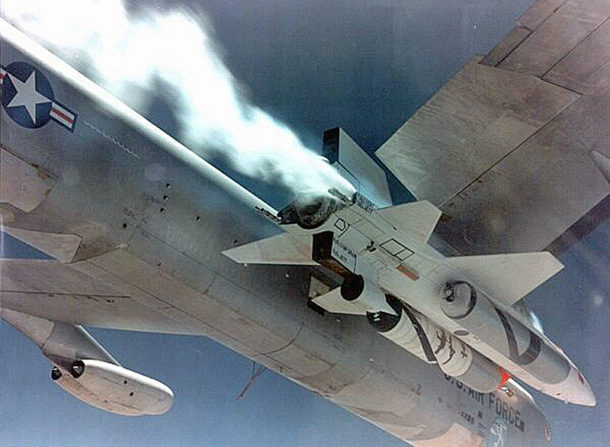
Fifty-one years ago this month, USAF Major William J. “Pete” Knight piloted the fabled USAF/North American X-15A-2 rocket-powered hypersonic flight research aircraft to a record speed of 4,520 mph – roughly a mile and a quarter per second. This mark is approximately 50 percent faster than the highest speed ever attained by a “speeding bullet”.
North American’s original X-15 production run consisted of three (3) aircraft. The X-15A-2 was a rebuild of the 2nd airframe (S/N 56-6671) which had been severely damaged during an emergency landing at Mud Lake, Nevada in November of 1962.
The rebuilt aircraft was configured with a pair of propellant-containing drop tanks that allowed the type’s XLR-99 rocket engine to operate 60 seconds beyond the stock X-15’s 80-second burn time. Among other modifications, the aircraft also carried a pylon-mounted dummy ramjet in the ventral region of the aft fuselage.
With the addition of the external propellant tanks, the X-15A-2 was really a three-stage vehicle. The first stage was the NASA NB-52B mothership which launched the X-15 at Mach 0.82 and 45,000 feet. The second stage consisted of the propellant-laden external tanks which were jettisoned at Mach 2.0 and 70,000 feet. The third stage was the X-15A-2 with its entire internal propellant load.
Due to the increased speed of the X-15A-2, the aircraft was covered with Martin MA-25S ablator to protect it from the higher aerodynamic heating loads. The baseline ablator was pink in color and gave the X-15A-2 a rather odd appearance. Fortunately, application of a white wear/sealer over the ablator gave the aircraft a more dignified look.
On Tuesday, 03 October 1967, Pete Knight and the X-15A-2 dropped away from the NB-52B (S/N 52-008) at the start of the X-15 Program’s 188th mission. Knight ignited the XLR-99 rocket engine and executed a pull-up followed by a pushover to level flight at a little over 102,000 feet. Aircraft speed at XLR-99 burnout was 4,520 mph (Mach 6.7).
As the aircraft decelerated following burnout, Knight executed a series of pre-planned flight maneuvers to acquire vital aerodynamics data. However, passing through Mach 5.5, he received an indication in the cockpit that a high temperature condition existed in the XLR-99 engine bay.
Knight attempted to jettison the aircraft’s remaining propellants, but to no avail. The jettison tubes were welded shut by whatever was happening in the engine bay. This meant he would land heavier and faster than usual. Fortunately, Knight’s piloting skills allowed him to get the X-15A-2 on to Rogers Dry Lake in one piece.
As flight support personnel inspected the X-15A-2 airframe following Knight’s emergency landing, they were alarmed at what they found. The aft ventral region of the aircraft had incurred significant thermal damage. Further, the dummy ramjet was gone.
As reported in the classic NASA document, TM-X-1669, higher-than-expected aerodynamic heating levels were responsible for the damage to the X-15A-2.
First, shock wave/boundary layer interaction heating on the lower fuselage just ahead of the pylon (1) completely destroyed the ablator in that region and (2) penetrated the Inconel-X airframe structure. This introduced very high temperature air into the X-15 engine bay.
Second, impingement of the dummy ramjet nose shock on the detached bow shock coming off of the pylon produced a shear layer that focused on the pylon leading edge. The resulting heating rates were of sufficient magnitude and duration to both burn away the pylon ablator and burn through the pylon structure. The weakened pylon structural attachment eventually failed and the dummy ramjet departed the main airframe.
Pete Knight will forever hold the record for the fastest X-15 flight. However, the X-15A-2 never flew again. Only 11 more flights remained in the X-15 Program at the time. A lack of time and funding meant that little was to be gained by repairing the thermally-damaged aircraft.
As for the final disposition of the X-15A-2 (S/N 56-6671), the aircraft’s remaining ablator was removed with its external surface cleaned-up and original markings restored. The aircraft now resides in a place of honor at the National Museum of the United States Air Force located at Wright-Patterson AFB in Dayton, Ohio.
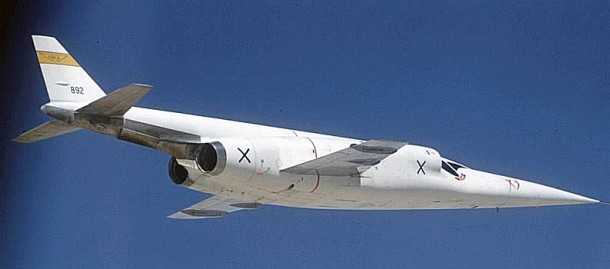
Sixty-four years ago this week, the USAF/Douglas X-3 Stiletto experimental flight research aircraft encountered a violent dynamic instability during a flight test maneuver. NACA test pilot Joseph A. Walker was able to successfully recover the aircraft from this flight upset known as Inertial Roll Coupling.
The X-3 was designed to fly at speeds up to Mach 2. The aircraft was approximately 67 feet in length and had a wing span on the order of 23 feet. Aircraft gross take-off weight was 23,840 pounds.
A pair of Westinghouse J46-WE-1 turbojets were intended to power the X-3. However, protracted developmental problems and installation issues with these powerplants would eventually prevent their use in the aircraft.
The X-3 was ultimately outfitted with a pair of Westinghouse J34-WE-17 turbojets. The result was that the X-3 was now grossly underpowered and could barely fly supersonically. Indeed, the Stiletto’s maximum demonstrated Mach number was 1.21 which was achieved in a 30-deg dive!
Notwithstanding the above, the X-3 took to the air 54 times between October 1952 and May 1956 for the purpose of conducting transonic flight research. However, it would be on the type’s 43rd flight that the X-3 would make perhaps its most important contribution to aviation.
On Wednesday, 27 October 1954, Joe Walker took-off in the X-3 (S/N 49-2892) from Edwards Air Force Base, California. At Mach 0.92 and 30,000 feet, Walker applied left aileron at fixed-rudder in an effort to develop a rapid roll response. To Walker’s utter amazement, the X-3 went wild in both pitch and yaw.
Although it seemed to last much longer, Walker was able to recover control of the X-3 within 5 seconds of his initial left aileron input. In true test pilot fashion, Walker again made an abrupt rudder-fixed left aileron input at Mach 1.05. The same thing happened. However, this time the aircraft’s motions were more violent.
Happily, Walker again recovered control of the X-3. Having had enough of flight test frontiersmanship for one day, the intrepid Walker uneventfully recovered the experimental aircraft back at Edwards.
The phenomenon that Joe Walker and the X-3 encountered that day in 1954 is known as Inertial Roll Coupling. It is a resonant divergence in either pitch or yaw due to the presence of roll rate. Aircraft like the X-3, which have low longitudinal and/or directional static stability as well as high pitch-to-roll and yaw-to-roll moment of inertia ratios, are especially susceptible to this phenomenon.
As a postscript to our story, the phenomenon of Inertial Roll Coupling had been hypothesized by the NACA’s William H. Phillips back in June of 1948. For Joe Walker in October of 1954, engineering theory would become flight test fact in a few terrifying seconds high in the skies over Edwards Air Force Base.
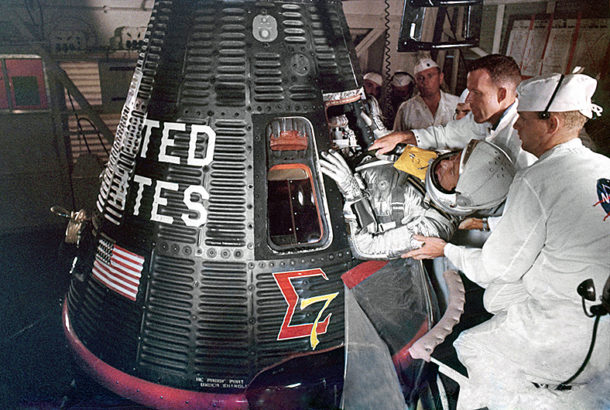
Fifty-six years ago this month, Mercury Astronaut Walter M. Schirra, Jr. orbited the Earth six (6) times in his Mercury spacecraft code-named Sigma 7. The near-perfect 9-hour spaceflight was the United States’ third manned orbital mission flown within a period of eight (8) months.
Project Mercury was United States’ first manned spaceflight program. This historic pioneering space effort helped lay the foundation for America’s quest for the Moon. A total of six (6) missions (2 sub-orbital and 4 orbital) was flown between May of 1961 and May of 1963.
The Mercury Spacecraft measured 11.5 feet in length and had a diameter of 6.2 feet. Orbital weight was roughly 3,000 pounds. With a cockpit volume of only 60 cubic feet, an astronaut’s corporeal fit inside the spacecraft was exceedingly tight. Vehicle entry and egress was a real shoe-horning process. It is not complete hyperbole to say that, once inside, an astronaut wore, more than rode in, the Mercury space vehicle.
Despite its diminutive size, the Mercury Spacecraft was an able space-faring ship. Indeed, it was configured with a complete suite of life support, navigation, attitude control, communications, deboost, recovery and thermal protection systems. Aided by a vast national mission support team, recovery force, and world-wide tracking system, the Mercury spaceflight effort was entirely successful in establishing America in space.
America’s first astronauts were known as the Mercury Seven. History records their names; Shepard, Grissom, Glenn, Carpenter, Schirra, Cooper and Slayton. In the tense 1960’s Space Race with the Soviet Union, these men were indeed America’s Single-Combat Warriors immortalized by the late author Tom Wolfe in his classic book, The Right Stuff.
Mercury-Atlas No. 8 (MA-8) was the fifth Mercury mission. Whereas the two (2) previous flights had been three (3) orbit missions, MA-8 was scheduled to orbit the Earth six (6) times. The focus would be on spacecraft operations instead of space science. The intent was to verify that the Mercury spacecraft could be cleared for an orbital mission duration of at least 24 hours on the very next flight
As was the custom for a Mercury astronaut, Schirra personally named his orbital steed. As such, Schirra chose the name Sigma 7. The term Sigma, the Greek mathematical symbol for summation, signified a summation or culmination of flight experience and engineering development that led to a mature Mercury Spacecraft system. The numeral 7 represented the Mercury Seven.
The MA-8 mission began with lift-off from Cape Canaveral’s LC-14 at 12:15:12 UTC on Wednesday, 03 October 1962. The Atlas D launch vehicle placed Schirra into a 152.8-nm x 86.9-nm orbit. Once in orbit, Schirra quickly got down to business. This included tracking the Atlas booster, maneuvering the spacecraft, observing and photographing the Earth, and conducting various scientific experiments.
Schirra did a particularly good job at conserving the precious supply of Reaction Control System (RCS) fuel. One of the MA-8 objectives had been to do so. In fact, Schirra conserved fuel even more efficiently than planned. Other than an annoying and uncomfortable spacesuit heating problem that occurred several times, the entire MA-8 mission was what Schirra would ultimately call “textbook”.
MA-8 retro-fire occurred at 21:07:12 UTC. During the reentry, the automatic rate stabilization system damped spacecraft pitch and yaw oscillations. Drogue and main parachute deployment took place at 40,000 feet and 15,000 feet, respectively. Splashdown in the Pacific Ocean occurred 1,200 nm northwest of Hawaii at 21:28:22 UTC.
The success of MA-8 paved the way to Gordon Cooper’s historic 22-orbit, 34-hour MA-9 mission in May of 1963. The Gemini and Apollo Programs would soon follow. Wally Schirra would play a big part in both. He commanded the historic Gemini 6 orbital rendezvous mission in December of 1965. Schirra also went on to command the critical Apollo 7 mission in October of 1968.
Wally Schirra was the only member of the Mercury Seven to orbit the Earth in Mercury, Gemini and Apollo spacecraft. He left this earthly scene in May 2007 at the age of 84.
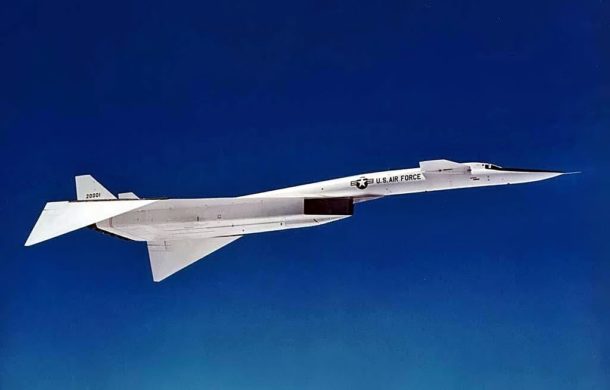
Fifty-three years ago this month, the USAF/North American XB-70A Valkyrie reached three times the speed of sound for the first time. This historic aviation achievement took place on the 18th anniversary of the breaking of the sound barrier by the USAF/Bell XS-1.
When it comes to legendary aircraft, aviation enthusiasts speak in almost reverent terms about the XB-70A Valkyrie. Indeed, few aircraft have evoked such utter awe or symbolized better the profound majesty of flight than the “The Great White Bird”. Though its flight history was brief, the XB-70A’s influence on aviation has proven to be of enduring worth.
The Valkyrie measured 185 feet in length, had a wingspan of 105 feet and an empty weight of 210,000 pounds. With a GTOW of 550,000 pounds, it was the heaviest supersonic-capable aircraft of all-time. The aircraft was powered by a six-pack of General Electric YJ93-GE-3 turbojets generating more than 172,000 pounds of thrust in afterburner.
To enhance lift-to-drag ratio and directional stability at high Mach number, the Valkyrie was configured with wing tips that could be deflected downward as much as 65 degrees. Each wing tip was the size of an USAF/Convair B-58A Hustler wing panel. To this day, the XB-70A deflectable wing tip is the largest control surface ever used on an aircraft.
The XB-70A was originally intended to be a supersonic strategic bomber. The aircraft’s mission was to penetrate Soviet airspace at Mach 3 and deliver nuclear ordnance from an altitude of 72,000 feet. However, the rapid ascendancy of Soviet surface-to-air missile capability would compromise the type’s military mission before it even flew.
As a consequence of the above, the Valkyrie ultimately became a high-speed flight research aircraft. Only two (2) copies were constructed and flown. Ship No. 1 (S/N 62-0001) made its maiden flight on Monday, 21 September 1964 while Ship No. 2 (62-0207) first took to the air on Saturday, 17 July 1965.
XB-70A Ship No. 1 became the first Valkyrie to reach Mach 3. It did so while flying at an altitude of 70,000 feet on Thursday, 14 October 1965. The flight crew consisted of North American Aviation test pilot Alvin S. White (aircraft commander) and USAF Colonel Joseph Cotton (co-pilot).
The XB-70A aircraft flew all of their flight research missions out of Edwards Air Force Base in California. Between September of 1964 and February of 1969, a total of 129 XB-70A research flights took places; 83 by Ship No. 1 and 46 by Ship No. 2. A total of nearly 253 flight hours was amassed by the aircraft.
The XB-70A Program made significant contributions to high-speed aircraft technology including aerodynamics, aerodynamic heating, flight controls, structures, materials, and air-breathing propulsion. Lessons-learned from its flight research have been applied to numerous aircraft developments including the B-1A, American SST, Concorde and the TU-144.
XB-70A Ship No. 1 survived the flight test program while Ship No. 2 did not. The latter was destroyed in a mid-air collision with a NASA F-104N on Wednesday, 08 June 1966. Today, XB-70A Ship No. 1 can be seen at the National Museum of the United States Air Force at Wright-Patterson Air Force Base in Dayton, Ohio.
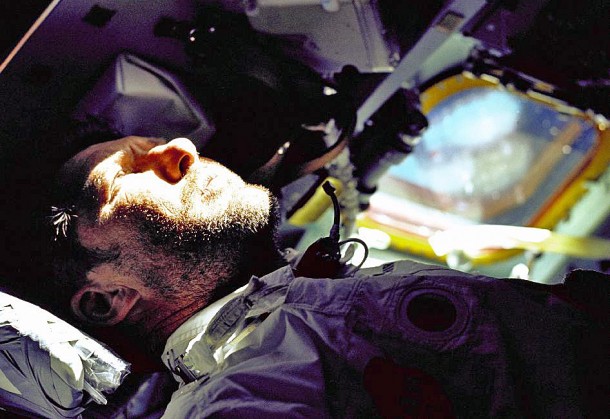
Fifty years ago this month, NASA successfully conducted the first manned Apollo Earth-orbital mission with the flight of Apollo 7. This mission was a critically-important milestone along the path to the first manned lunar landing in July 1969.
The launch of Apollo 7 took place from Launch Complex 34 at Cape Canaveral Air Force Station, Florida at 15:02:45 UTC on Friday, 11 October 1968. The flight crew consisted of NASA astronauts Walter M. Schirra, Donn F. Eisele, and R. Walter Cunningham. Their primary goal was to thoroughly qualify the new Apollo Block II Command Module (CM) during 11 days in space.
Apollo 7 was not only the first flight of the Block II CM, but in fact the first manned mission in the Apollo Program. Apollo 7 also featured the first use of the Saturn IB launch vehicle in a manned mission. Apollo 7′s critical nature stemmed from the tragic Apollo 1 fire that took the lives of Virgil I. (Gus) Grissom, Edward H. White II, and Roger B. Chaffee on Friday, 27 January 1967.
The Apollo 1 fire was attributed to numerous deficiencies in the design, construction, and testing of its Block I CM. The Block II spacecraft flown on Apollo 7 was a major redesign of the Apollo Command Module and was in every sense superior to the Block I vehicle. However, it had taken 21 months to return to flight status and the Nation’s goal of a manned lunar landing within the decade of the 1960′s was in serious jeopardy.
The Apollo 7 crew orbited the Earth 163 times at an orbital altitude that varied between 125 and 160 nautical miles. In that time, they rigorously tested every aspect of their Block II CM. This testing included 8 firings of the Service Propulsion System (SPS) while in orbit. Apollo 7 splashdown occurred in the Atlantic Ocean near the Bermuda Islands at 11:11:48 UTC on Tuesday, 22 October 1968.
The Nation’s Lunar Landing Program overwhelmingly got the unqualified success that it desperately needed from the Apollo 7 mission. The Apollo Block II CM would provide yeoman service throughout the time of Apollo. The spacecraft would also go on to see service in the Skylab and Apollo-Soyuz Test Project programs.
While the technical performance of the Apollo 7 crew was unquestionably superb, their interaction with Mission Control at Johnson Spacecraft Center (JSC) in Houston, Texas was quite strained. The crew suffered from head colds through much of the mission and the food quality was poor. Coupled with Houston’s incessant attempts to cram more tasks into each moment of the mission, Apollo 7 Commander Schirra took charge of his ship and made the ultimate decisions as to what work would be performed onboard the spacecraft.
The flight of Apollo 7 would be Wally Schirra’s last mission in space as he had announced prior to launch. As history records, he holds the distinction of being the only astronaut to have flown Mercury, Gemini, and Apollo space missions.
Interestingly, Apollo 7 was not only Schirra’s last time in space, but it was Donn Eisele’s and Walt Cunningham’s first and last space mission as well. That there is a direct connection between this historical fact and the crew’s insubordinate behavior during Apollo 7 is obvious to the inquiring mind.





